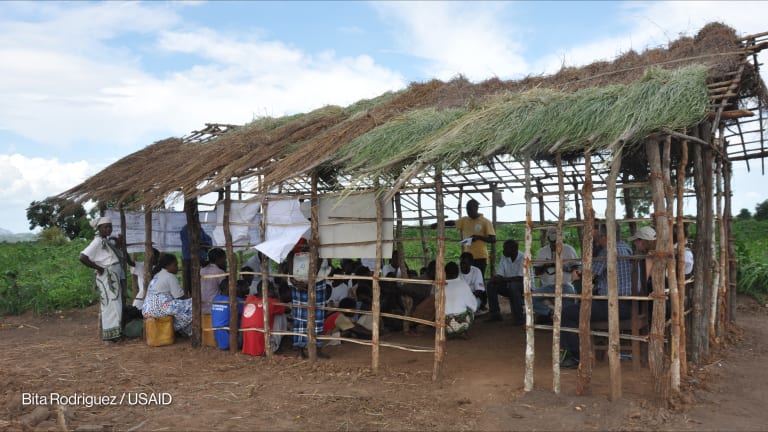Oxfam pivots to tackle the food crisis in Africa
Oxfam GB is hiring more staff and shifting its programs in the Horn, East and Central Africa region to respond to the food crisis and its consequences, including rising gender-based violence, says regional director Parvin Ngala.
Think about the consequences of the global food crisis and hunger and malnutrition are probably the first things that come to mind, but many aid organizations are already seeing wide-ranging knock-on effects. In the Horn, East, and Central Africa region that includes consequences for gender equality, said Parvin Ngala, Oxfam GB’s director for the region. Ngala said the food crisis is impacting Oxfam’s work around women’s economic empowerment and driving sexual violence and child marriage. Nearly 200 million people experienced food insecurity in 2021, according to the United Nations. That number is growing as the crisis in Ukraine pushes up food and energy prices, and drought and famine are also ravaging areas of Ethiopia, Somalia, South Sudan, and Yemen. For Oxfam GB’s team in the region, it has meant pivoting their work — which covers everything from peace programs to water and sanitation — to respond to the food crisis, according to Ngala. We are urging them to open up and allow resources to be flexible because at the moment we can’t compartmentalize — humanitarian assistance is actually part of the resilience needed for the long term. --— Parvin Ngala, Horn, East, and Central Africa region director, Oxfam GB Oxfam GB works across 12 countries in the region and employs more than 2,000 staffers, but it is now hiring more to help with the response. Ngala told Devex about the impacts she is seeing and what she believes donors need to do now. This is the first in a Devex Pro series on how organizations are responding to the global food crisis. This conversation has been edited for length and clarity. How is the food crisis affecting Oxfam GB’s work in the Horn, East and Central Africa region? We are having to get new staff because we need to expand our reach and ensure quick action to support communities. It’s also about putting all of our attention onto the food crisis … We are having to readjust all of our work because of the impact it is having. It’s very much all hands on deck. For example, in Ethiopia … our attention [has been] on the dialogue needed to resolve the conflict, [but now] we have also shifted to … make sure [people] get access to food because unfortunately, we’ve seen … how food is used as a weapon of war. So we are looking at how to reorient our work to keep the food security agenda. Where are you seeing the biggest impact? Kenya, Somalia, South Sudan, and Ethiopia are raising major concerns. But while the spotlight is on these countries, we do see expansion in the needs across other areas, so we are having to monitor and think about how we support them and adjust those programs. Obviously, hunger and malnutrition are major issues but what other impacts are you seeing? The work that we do around women’s economic empowerment, unpaid care, and sexual and gender-based violence is being affected by the food crises. We see issues when there is scarcity at the household level. In some places … the men move away to look for food for livestock and the women are left at home. As a result, some of the initiatives that we are investing in in terms of women’s economic empowerment have become a challenge to implement since the women are [totally] focused on keeping their children alive. There are also increases in violence because women are having to walk further to get water, for example, and we are also hearing of increases in young girls being married off because families are struggling with getting resources, so they are looking at negative coping mechanisms. Then there is the issue of rising food and commodity prices due to the crisis in Ukraine. We’re seeing a doubling of the price of wheat and sorghum in Somalia, while Ethiopia has the third highest rate of inflation on the continent. This goes beyond just food to all commodities, so it means communities are even more impacted. How are you responding? On the issue of rising food and commodity prices, we look at flexible cash assistance and work with national governments and partners in identifying a minimum expenditure basket so we can calculate the amount of cash needed to support minimum needs for affected households. Protection is also something we have to [embed in] our programs because we are seeing a lot of sexual and gender-based violence in communities. On the advocacy side, we keep insisting that we need resources for humanitarian assistance now. In May 2021, we were highlighting our concerns about the looming food crisis in the region and at that point, we were talking about 10 million people facing high levels of acute hunger [across Kenya, Somalia, and Ethiopia]. Now we are talking about more than 22 million people. The numbers are increasing by the day and … [with the United Nations appeals underfunded] we have to keep highlighting the agenda at the global stage. We are also pushing donors for flexible resources. Donors often make a distinction between long term and humanitarian resources, but we say there is no difference. … So we are urging them to open up and allow resources to be flexible because at the moment we can’t compartmentalize — humanitarian assistance is actually part of the resilience needed for the long term. What do you think needs to happen long-term to prevent this from happening again? We need to invest more in early action. We are potentially looking at another food crisis in 2027 and we can’t wait for it to happen. Some of our donors have also reduced their allocation towards the African continent because of their submissions to the Ukraine crisis, but as an organization, we are saying it’s not a matter of “either-or” but “and.” With climate change, we know that economic shocks and fluctuations are becoming more frequent, so we are advocating for investment around social protection mechanisms to support communities when it happens. We also need to relook at food systems globally because clearly, the current model is not sustainable. We need to look much more at developing regional markets and also how we work with smallholder farmers. Finally, we need to do something about climate finance. We need a big push from the global north, who are big drivers of climate change globally, towards financing loss and damage in the global south because this food crisis is part and parcel of the climate change crisis.
Think about the consequences of the global food crisis and hunger and malnutrition are probably the first things that come to mind, but many aid organizations are already seeing wide-ranging knock-on effects.
In the Horn, East, and Central Africa region that includes consequences for gender equality, said Parvin Ngala, Oxfam GB’s director for the region. Ngala said the food crisis is impacting Oxfam’s work around women’s economic empowerment and driving sexual violence and child marriage.
Nearly 200 million people experienced food insecurity in 2021, according to the United Nations. That number is growing as the crisis in Ukraine pushes up food and energy prices, and drought and famine are also ravaging areas of Ethiopia, Somalia, South Sudan, and Yemen.
This story is forDevex Promembers
Unlock this story now with a 15-day free trial of Devex Pro.
With a Devex Pro subscription you'll get access to deeper analysis and exclusive insights from our reporters and analysts.
Start my free trialRequest a group subscription Printing articles to share with others is a breach of our terms and conditions and copyright policy. Please use the sharing options on the left side of the article. Devex Pro members may share up to 10 articles per month using the Pro share tool ( ).
Sophie Edwards is a Devex Contributing Reporter covering global education, water and sanitation, and innovative financing, along with other topics. She has previously worked for NGOs, and the World Bank, and spent a number of years as a journalist for a regional newspaper in the U.K. She has a master's degree from the Institute of Development Studies and a bachelor's from Cambridge University.








